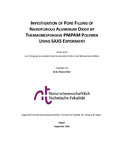Citation link:
http://dx.doi.org/10.25819/ubsi/10176| DC Field | Value | Language |
|---|---|---|
| dc.contributor.author | Erfani, Mona | - |
| dc.date.accessioned | 2022-09-06T10:41:24Z | - |
| dc.date.available | 2022-09-06T10:41:24Z | - |
| dc.date.issued | 2021 | de |
| dc.description.abstract | In this thesis we aim to determine the filling status and thermoresponsive behavior of polymer in the confinement of nanopores of aluminum oxide. The anodic aluminum oxide (AAO) nanopores are obtained by the anodization of the aluminum under certain conditions. The right choice of anodization condition enables us to achieve well-ordered hexagonal arrangement of circular pores. The AAO nanopores are then filled by thermoresponsive poly(N-isopropyl acrylamide) polymers (PNIPAM) with different percentages of solution concentration. The X-ray reflectivity (XRR) from polymers which are wetting on silicon substrates with various solution concentrations is used to determine their wetting and scattering properties. Samples with empty and filled pores are carefully calibrated and examined by small angle X-ray scattering (SAXS). The in-situ SAXS experiment at filled samples is performed at temperatures above and below the lower critical solution temperature (LCST) with the purpose to find differences of the effective pore diameter caused by different wetting behaviors at the pores inner surfaces. The 2D scattering pattern is converted to line profiles which contains the structural information of the sample. An analytical model of SAXS intensity taken from the sample system is adapted to describe the scattering properties of samples under investigation. The parameters of the model are obtained by fitting to the experimental data employing a Monte-Carlo algorithm. It is shown that the developed mathematical model describes the structural parameters of the AAO in reasonable agreement and are in good agreement with previous works. Particular details of the scattering pattern for the different measurements are found qualitatively with the help of a toy model. This model is built up by an analytical solution of the 2D gratings problem containing circular pinholes. The differences in samples with varied polymer solution concentrations as well as the differences for the measurements at various temperatures are estimated with the use of this model. More accurate model that can provide detailed and quantitative analysis of samples differences is explained. In this approach, the accuracy of the sample identification is a question of higher resolution of the measured data which can be gained by a different experimental setup. | en |
| dc.identifier.doi | http://dx.doi.org/10.25819/ubsi/10176 | - |
| dc.identifier.uri | https://dspace.ub.uni-siegen.de/handle/ubsi/2265 | - |
| dc.identifier.urn | urn:nbn:de:hbz:467-22651 | - |
| dc.language.iso | en | de |
| dc.subject.ddc | 530 Physik | de |
| dc.subject.other | SAXS | en |
| dc.subject.other | Monte Carlo algorithm | en |
| dc.subject.other | Nanoporous materials | en |
| dc.subject.other | Thermoresponsive polymer | en |
| dc.subject.other | Pore filling | en |
| dc.subject.swb | Röntgen-Kleinwinkelstreuung | de |
| dc.subject.swb | Thermoresponsive Polymere | de |
| dc.subject.swb | Nanoporöser Stoff | de |
| dc.subject.swb | Monte-Carlo-Simulation | de |
| dc.title | Investigation of pore filling of nanoporous aluminum oxide by thermoresponsive PNIPAM polymer using SAXS experiment | en |
| dc.title.alternative | Untersuchung der Porenfüllung von Nanoporösem Aluminiumoxid durch thermoresponsive PNIPAM-Polymer mittels SAXS-Experiment | de |
| dc.type | Doctoral Thesis | de |
| item.fulltext | With Fulltext | - |
| ubsi.contributor.referee | Pietsch, Ullrich | - |
| ubsi.date.accepted | 2022-03-18 | - |
| ubsi.organisation.granting | Universität Siegen | - |
| ubsi.origin.dspace5 | 1 | - |
| ubsi.publication.affiliation | Department Physik | de |
| ubsi.subject.ghbs | UDXM | de |
| ubsi.subject.ghbs | UIO | de |
| ubsi.subject.ghbs | UIQD | de |
| ubsi.subject.ghbs | UIQN | de |
| Appears in Collections: | Hochschulschriften | |
Files in This Item:
| File | Description | Size | Format | |
|---|---|---|---|---|
| Dissertation_Erfani_Mona.pdf | 6.34 MB | Adobe PDF |  View/Open |
This item is protected by original copyright |
Page view(s)
345
checked on Apr 3, 2025
Download(s)
158
checked on Apr 3, 2025
Google ScholarTM
Check
Altmetric
Items in DSpace are protected by copyright, with all rights reserved, unless otherwise indicated.

